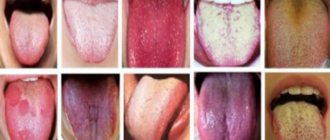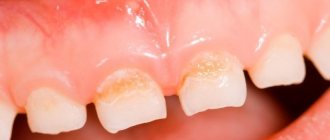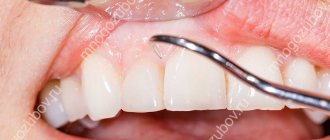Treatment
For your information! In certain cases, treatment may differ radically (based on the root cause of the appearance of white plaque).
So, depending on the underlying pathology, the patient is prescribed the following treatment:
- In case of problems with the gastrointestinal tract the diet is , excluding all harmful foods from the diet. First of all, fatty meat, fried foods, fast food. This also includes sour cream, butter, alcohol and sweet carbonated drinks. Prescribe medications appropriate to the current disease. The treatment is carried out by a gastroenterologist.
- For influenza and ARVI, antipyretics (Paracetamol, Ibuprofen, etc.) and drugs for topical use are prescribed Among them, nasal drops - Naphthyzin, Xylometazoline, Otrivin, etc.; tablets and lozenges for resorption with anti-inflammatory action - Doctor Mom, Strepsils, etc.
- In case of fungal infection of the oral cavity , the patient is prescribed antifungal drugs. Among them: Rumicosis, Fungicidin, Diflucan, Nystatin, etc.
- If you have a sore throat and other throat diseases , drugs such as Faringosept, Ingalipt, Neo-angin, Septolete , etc. are recommended. Antiseptics (Miramistin and Chlorhexidine), Furacilin solution (1 tablet per glass of warm water) are prescribed as rinses. You can use a soda-salt solution (1 teaspoon of each per glass of warm water). Decoctions of chamomile, sage, and calendula are also suitable (1 tablespoon of raw material per glass of boiling water).
- For bacterial infections , oral antibiotics are indicated (Sumamed, Amoxiclav, Cephalexin, Azitrox, etc.). In this case, it is necessary to complete the full course of treatment. Even if the symptoms go away a few days after starting therapy.
- For glossitis , first of all, it is necessary to exclude hot and spicy foods from the diet. Remove from the diet too salty, with the addition of red or black pepper, garlic, onion, mustard, various sauces, etc. And it is important to rinse your mouth with Chlorhexidine, Miramistin, a weak solution of potassium permanganate, Furacilin, herbal infusions, etc. .
- In case of hormonal disorders , treatment is carried out by an endocrinologist. The course of treatment and dosage of certain medications is prescribed by the doctor. Self-medication is unacceptable, because without knowing the true cause of plaque, therapy will be meaningless and can only worsen the situation.
Pharyngitis - symptoms and treatment
Treatment of acute pharyngitis begins with organizing a regimen and nutrition :
- gentle regime with enough sleep;
- creating conditions for the normal functioning of the mucous membrane - cool, moist air, eliminating active and passive smoking, contact with dust and irritants;
- diet excluding spicy and rough foods;
- warm drinks, alkaline rinses and inhalations [12].
Sometimes these measures already lead to an improvement in the condition. As prescribed by a doctor, to reduce the symptoms of pharyngitis caused by inflammation, complex products are used in the form of tablets, aerosols, rinses :
- antiseptics (chlorhexidine, hexetidine, benzydamine, iodine preparations, plant extracts, etc.);
- sometimes antibiotics (gramicidin);
- anti-inflammatory drugs (ketoprofen);
- local anesthetics (lidocaine, tetracaine, menthol) [13].
The choice of drugs is large, but excessive use can lead to suppression of the normal microflora of the pharynx, decreased local immunity, allergic reactions, damage to the mucous membrane; in addition, their effectiveness in viral infections has not been proven [7].
To reduce the temperature, non-steroidal anti-inflammatory drugs (ibuprofen, paracetamol) are prescribed.
Treatment of bacterial pharyngitis
Specific treatment of acute and chronic pharyngitis in adults with bacterial pathogens, especially with GABHS (group A beta-hemolytic streptococcus) is systemic antibiotic therapy. The drugs of choice are antibiotics from the group of semisynthetic penicillins (amoxicillin). Often sick children who have a variety of pathogenic flora on their mucous membranes are prescribed protected aminopenicillins (amoxicillin + clavulanic acid). When mycoplasma or chlamydia is detected, antibiotics are prescribed when the process descends into the bronchi and lungs or the disease becomes protracted [7]. Macrolide antibiotics (azithromycin, clarithromycin) are used.
Viral pharyngitis does not require antibiotic therapy.
Treatment of fungal pharyngitis
For mycoses, local antimycotic agents are used (co-trimoxazole, pimafucin, 2% alkaline solution). If local therapy does not help, antifungal antibiotics (amphotericin B) or special antifungal agents (ketoconazole, mycoheptin, fluconazole) are prescribed.
Treatment of chronic pharyngitis
Treatment of chronic pharyngitis during an exacerbation is no different from treatment of the acute form of the disease. It includes symptomatic therapy, proper organization of daily routine and food intake.
Purulent pharyngitis is not isolated, so there are no separate recommendations for its treatment.
Treatment of pharyngitis at home
Mild acute viral pharyngitis, if you follow a home regimen and regular warm drinks, goes away within seven days. However, the disease can occur not only due to a viral infection, but also for another reason. Therefore, without making a diagnosis, you should not self-medicate.
Physiotherapy
For obsessive dry cough and dry throat, you can use inhalations with saline solution as directed by your doctor.
Surgery
Surgical treatment consists of correcting the nasal septum and removing nasopharyngeal polyps. Surgery is necessary if the cause of chronic pharyngitis is constantly difficult nasal breathing. Removal of adenoids and tonsils is carried out according to strict indications. The decision on the need for surgery is made by an otolaryngologist after a thorough diagnosis.
Possible reasons
Possible causes of the appearance of white plaque in combination with a sore throat include the following factors:
Minor injuries and any other damage to the tongue
For example, a person accidentally cuts his tongue with a fork or toothpick, and pathogenic bacteria penetrate through the damaged tissue, causing inflammation.
Long-term use of any medications
If a person has been taking antibiotics, steroids or other drugs for a long time , such symptoms may appear.
Hormonal disorders in the body
In women, this can happen during menopause.
Associated symptoms in this case: burning and dry mouth, increased sweating.
Gastrointestinal pathologies
Stay up to date! This can be gastritis with low or high acidity, stomach and duodenal ulcers, colitis or enterocolitis, etc.
Diseases of the digestive tract are usually accompanied by symptoms such as abdominal pain, nausea, constipation or diarrhea, and heartburn.
Inflammation of the gallbladder
Associated symptoms: pain in the lower abdomen (on the right side), dry mouth, high fever.
Infectious diseases
Among them are dysentery, scarlet fever, diphtheria, immunodeficiency virus and others.
Infections, as a rule, are not limited to just plaque and sore throat.
- White plaque on tonsils in adults: causes, methods of treatment
Usually accompanied by the following symptoms: body temperature above 38-39 degrees, muscle pain and aches, skin rash, diarrhea, vomiting.
Diseases of the throat and oral cavity
Keep in mind! As a rule, tonsillitis, tonsillitis, pharyngitis, stomatitis are characterized by such symptoms.
This may increase body temperature (in some cases) and cause weakness in the body . There may also be problems with swallowing food, burning and dry mouth, hoarseness in the voice, etc.
Viral infections
This is the flu, ARVI .
Associated symptoms: high fever, headache, cough, runny nose, body aches.
Oral candidiasis
This is usually a fungal infection of the mouth.
The disease most often occurs in young children and is accompanied by severe pain, burning and dry mouth.
Note! In this case, a white, cheesy coating is observed not only on the tongue, but also on the lips and the inside of the cheeks.
Glossitis
This is an inflammation of the tongue caused by injury or exposure to pathogenic microorganisms.
Oral leukoplakia
A disease of the mucous membrane of non-infectious etiology, in which white thickenings form on the gums, tongue and inner surface of the cheeks .
According to Ayurveda, the tongue is divided into several parts, each of which is responsible for a particular organ.
- White plaque in the throat in a child or adult - causes of appearance, means of treatment
Therefore, plaque on the front of the tongue indicates problems with the heart and liver, and near the root - intestinal pathologies.
If deposits are in the central part, they indicate a dysfunction of the spleen, stomach and pancreas.
It is worth noting! Formations in the lateral part (both on the left and on the right side) indicate problems with the kidneys.
What color is the pathological plaque?
By the color of the coating on the tongue, you can determine which organ malfunction caused it:
| White | A light whitish coating that can be easily cleaned with hygiene procedures is the norm for an adult. A cause for concern is if the white coating is dense or has a cheesy structure and is not cleaned. This may be a sign of a fungal infection. Other reasons include: monotonous diet, lack of vitamins, poor hygiene, smoking, intoxication, wearing dentures, taking medications. |
| Grey | Sometimes the tongue becomes covered with a gray coating when taking antibiotics for a long time. Also accompanies diseases of the gastrointestinal tract. |
| Yellow | Often indicates liver disease (in such cases a bitter taste is felt in the mouth). It can also occur with diseases of other organs of the digestive tract, with viral diseases, with an excess of bile in the body. |
| Green | This is a rare occurrence. Most often it is an indicator of liver problems. |
| Brown | Occurs with disorders of the digestive tract, alcoholism and smoking, and abuse of brown foods (chocolate, coffee, black tea). |
| Orange | It occurs mainly with gastritis, due to the fact that gastric juice enters the oral cavity in large quantities. |
| Blue | It may appear due to problems in the cardiovascular system, kidneys, due to a lack of folic acid, iron, Vit C, Vit B12. It can also appear due to mercury and heavy metal poisoning. |
| Black | Appears in cases of liver dysfunction, lead poisoning, acute infections, Crohn's disease, acidosis. |
Diagnostics
After a visual examination of the oral cavity and analysis of the patient’s complaints, the patient is sent for a general blood test and a mouth smear for bacterial culture (bacteriological culture).
Next, based on the results of the studies, the patient is referred to the appropriate specialist.
It depends on the underlying disease and then treatment is prescribed.
But if gastrointestinal diseases or hormonal disorders are suspected, are prescribed by appropriate specialists.
In what case should you consult a doctor and undergo an examination?
The following signs are reasons to consult a doctor:
- The presence of a dense, cheesy plaque , which is not removed when brushing the teeth and mouth or quickly appears again.
- Edema and swelling of the tongue.
- Bad breath .
- Pain and burning in the abdomen , eating disorders.
- Presence of small ulcers in the mouth .
- Rash on the face and body.
- Impaired taste sensitivity.
- Dryness and burning in the mouth.
- High body temperature.
- Constant weakness and lack of energy.
Remember! All of the above symptoms should be a cause for concern and immediate consultation with a doctor (ENT specialist, therapist, dentist or gastroenterologist).
How to avoid candidiasis?
To prevent the disease, you must follow a few simple rules:
- maintain oral hygiene;
- consult a dentist at least twice a year, even if there are no complaints;
- control nutrition, avoid excess carbohydrates in food;
- refrain from smoking, which can cause a chronic form of the disease.
Treatment of candidiasis of the oral mucosa can take a long time and also cause irreparable harm to health, so we recommend that you take care of yourself in advance by following preventive measures. If symptoms have already begun to appear, consult a doctor as soon as possible so that the infection does not have time to spread to other organs. You can undergo oral cavity diagnostics at Comfort Dentistry. Our specialists will tell you in detail about the prevention of common diseases of teeth and gums, and also, if necessary, provide high-quality treatment.
Associated symptoms
White coating on the tongue is usually accompanied by the following symptoms:
- burning and dry mouth;
- increased thirst;
- increased body temperature;
- heartburn and belching;
- bad breath;
- muscle weakness and causeless fatigue;
- severe sore throat, aggravated by eating;
- craving for sweets (one of the signs of candidiasis);
- irritable bowel syndrome (diarrhea, pain, etc.) and bloating.
You should know! At the same time, some of the accompanying symptoms may be absent in certain cases (depending on the underlying disease - the root cause of the appearance of white plaque).
- White plaque in the throat: in children and adults. Causes and treatment











